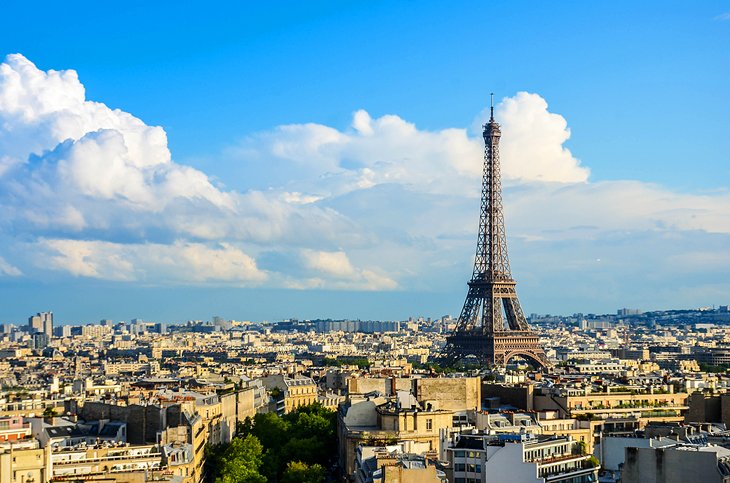With an estimated May 2021 population of 67.413 million people, France is the 20th most populous country in the world, the third-most populous in Europe (after Russia and Germany), and the second most populous in the European Union (after Germany).
Most French people are of Celtic-Gallic origin, with a significant admixture of Italic (Romans) and Germanic (Franks) groups reflecting centuries of respective migration and settlement. Through the course of the Middle Ages, France incorporated various neighbouring ethnic and linguistic groups, as evidenced by Breton elements in the west, Aquitanian in the southwest, Scandinavian in the northwest, Alemannic in the northeast, and Ligurian in the southeast.
France is a highly urbanised country, with its largest cities (in terms of metropolitan area population in 2016) being Paris (12,568,755 inh.), Lyon (2,310,850), Marseille (1,756,296), Toulouse (1,345,343), Bordeaux (1,232,550), Lille (1,187,824), Nice (1,006,402), Nantes (961,521), Strasbourg (785,839) and Rennes (727,357).
According to Article 2 of the Constitution, the official language of France is French, a Romance language derived from Latin. Since 1635, the Académie française has been France’s official authority on the French language, although its recommendations carry no legal weight. There are also regional languages spoken in France, such as Occitan, Breton, Catalan, Flemish (Dutch dialect), Alsatian (German dialect), Basque, and Corsican (Italian dialect). Italian was the official language of Corsica until 9 May 1859.
France is a secular country in which freedom of religion is a constitutional right. French religious policy is based on the concept of laïcité, a strict separation of church and state under which public life is kept completely secular.
1-Eiffel Tower

The design of the Eiffel Tower is attributed to Maurice Koechlin and Émile Nouguier, two senior engineers working for the Compagnie des Établissements Eiffel. It was envisioned after discussion about a suitable centerpiece for the proposed 1889 Exposition Universelle, a world’s fair to celebrate the centennial of the French Revolution. Eiffel openly acknowledged that inspiration for a tower came from the Latting Observatory built in New York City in 1853.In May 1884, working at home, Koechlin made a sketch of their idea, described by him as “a great pylon, consisting of four lattice girders standing apart at the base and coming together at the top, joined together by metal trusses at regular intervals”. Eiffel initially showed little enthusiasm, but he did approve further study, and the two engineers then asked Stephen Sauvestre, the head of the company’s architectural department, to contribute to the design. Sauvestre added decorative arches to the base of the tower, a glass pavilion to the first level, and other embellishments.
The puddle iron (wrought iron) of the Eiffel Tower weighs 7,300 tonnes, and the addition of lifts, shops and antennae have brought the total weight to approximately 10,100 tonnes. As a demonstration of the economy of design, if the 7,300 tonnes of metal in the structure were melted down, it would fill the square base, 125 metres (410 ft) on each side, to a depth of only 6.25 cm (2.46 in) assuming the density of the metal to be 7.8 tonnes per cubic metre.Additionally, a cubic box surrounding the tower (324 m × 125 m × 125 m) would contain 6,200 tonnes of air, weighing almost as much as the iron itself. Depending on the ambient temperature, the top of the tower may shift away from the sun by up to 18 cm (7 in) due to thermal expansion of the metal on the side facing the sun.
Gustave Eiffel engraved on the tower the names of 72 French scientists, engineers and mathematicians in recognition of their contributions to the building of the tower. Eiffel chose this “invocation of science” because of his concern over the artists’ protest. At the beginning of the 20th century, the engravings were painted over, but they were restored in 1986–87 by the Société Nouvelle d’exploitation de la Tour Eiffel, a company operating the tower.
Maintenance of the tower includes applying 60 tons of paint every seven years to prevent it from rusting. The tower has been completely repainted at least 19 times since it was built. Lead paint was still being used as recently as 2001 when the practice was stopped out of concern for the environment
The nearest Paris Métro station is Bir-Hakeim and the nearest RER station is Champ de Mars-Tour Eiffel. The tower itself is located at the intersection of the quai Branly and the Pont d’Iéna.
More than 250 million people have visited the tower since it was completed in 1889.In 2015, there were 6.91 million visitors. The tower is the most-visited paid monument in the world. An average of 25,000 people ascend the tower every day which can result in long queues.
The tower has two restaurants: Le 58 Tour Eiffel on the first level, and Le Jules Verne, a gourmet restaurant with its own lift on the second level.From 1937 until 1981, there was a restaurant near the top of the tower. It was removed due to structural considerations; engineers had determined it was too heavy and was causing the tower to sag.
As one of the most iconic landmarks in the world, the Eiffel Tower has been the inspiration for the creation of many replicas and similar towers. An early example is Blackpool Tower in England. The mayor of Blackpool, Sir John Bickerstaffe, was so impressed on seeing the Eiffel Tower at the 1889 exposition that he commissioned a similar tower to be built in his town. It opened in 1894 and is 158.1 m (518 ft) tall.Tokyo Tower in Japan, built as a communications tower in 1958, was also inspired by the Eiffel Tower.
2.Disneyland Paris

Disneyland Paris is an entertainment resort in Chessy, France, 32 km (20 mi) east of Paris. It encompasses two theme parks, resort hotels, Disney Nature Resorts, a shopping, dining and entertainment complex, and a golf course. Disneyland Park is the original theme park of the complex, opening in 1992. A second theme park, Walt Disney Studios Park, opened in 2002. Disneyland Paris celebrated its 25th anniversary in 2017, by when 320 million people had visited, making it the most visited theme park in Europe. It is the second Disney park outside the United States, following the opening of the Tokyo Disney Resort in 1983, and the largest.
Disneyland Paris and its properties have been subject to a number of name changes, initially an effort to overcome the negative publicity that followed the inception of the Euro Disney Resort.
12 April 1992 – 31 May 1994: Euro Disney Resort
1 June – 30 September 1994: Euro Disneyland Paris
1 October 1994 – 15 March 2002, 4 April 2009–present: Disneyland Paris
16 March 2002 – 3 April 2009: Disneyland Resort Paris
Disneyland Paris contains 2 theme parks, 8 resort hotels, 7 associated hotels, a golf course, a high-speed rail station, a large outlet centre (la vallée village), and a large shopping mall: Val d’Europe.
Parks
Disneyland Park opened with the resort on 12 April 1992 and is based on a larger scale of the original Disneyland in California and the Magic Kingdom in Florida.
Walt Disney Studios Park opened on 16 March 2002 celebrating show business, films, and behind-the-scenes
According to the Disneyland Paris website the theme park’s top five attractions in Disneyland Park are It’s a Small World, Star Wars Hyperspace Mountain (formerly known as Space Mountain: Mission 2), Big Thunder Mountain, Pirates of the Caribbean, and Buzz Lightyear’s Astro Blasters. It’s a Small World, located in Fantasyland, takes visitors on a musical tour of world attractions;Star Tours and Hyperspace Mountain (which is a roller coaster) are situated in the Discoveryland district; Big Thunder Mountain is a mine train roller coaster within Frontierland; Pirates of the Caribbean is located in Adventureland; and Buzz Lightyear’s Astro Blasters, also located in Discoveryland, was inspired by the Disney/Pixar film Toy Story 2 and features people attempting to successfully shoot lasers at seemingly moving targets to earn as many points as possible.
3.Louvre Museum
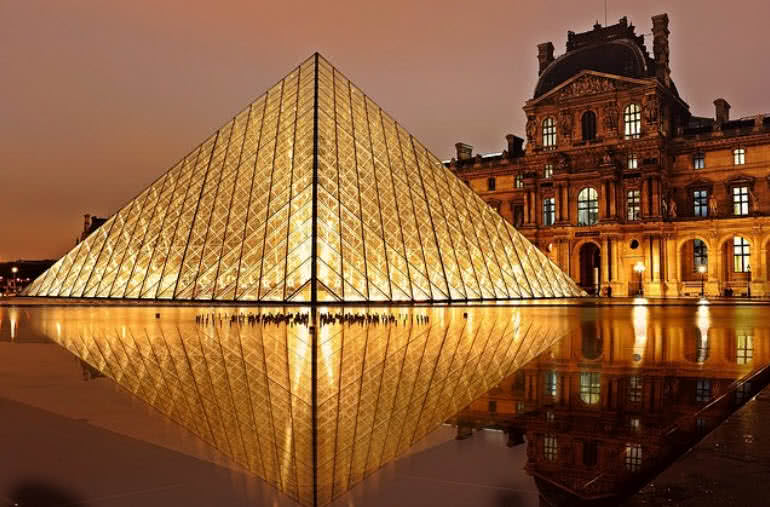
The Louvre museum is located inside the Louvre Palace, in the center of Paris, adjacent to the Tuileries Gardens. The two nearest Métro stations are Louvre-Rivoli and Palais Royal-Musée du Louvre, the latter having a direct underground access to the Carrousel du Louvre commercial mall.
Before the Grand Louvre overhaul of the late 1980s and 1990s, the Louvre had several street-level entrances, most of which are now permanently closed. Since 1993, the museum’s main entrance has been the underground space under the Louvre Pyramid, or Hall Napoléon, which can be accessed from the Pyramid itself, from the underground Carrousel du Louvre, or (for authorized visitors) from the passage Richelieu connecting to the nearby rue de Rivoli. A secondary entrance at the Porte des Lions, near the western end of the Denon Wing, was created in 1999 but is not permanently open.
The Louvre Palace, which houses the museum, was begun by King Philip II in the late 12th century to protect the city from the attack from the West, as the Kingdom of England still held Normandy at the time. Remnants of the Medieval Louvre are still visible in the crypt. Whether this was the first building on that spot is not known, and it is possible that Philip modified an existing tower.
The Louvre finally became a public museum during the French Revolution. In May 1791, the National Constituent Assembly declared that the Louvre would be “a place for bringing together monuments of all the sciences and arts”.On 10 August 1792, Louis XVI was imprisoned and the royal collection in the Louvre became national property. Because of fear of vandalism or theft, on 19 August, the National Assembly pronounced the museum’s preparation as urgent. In October, a committee to “preserve the national memory” began assembling the collection for display
The Louvre (English: /ˈluːv(rə)/ LOOV(-rə)), or the Louvre Museum (French: Musée du Louvre (audio speaker iconlisten)), is the world’s most-visited museum, and a historic landmark in Paris, France. It is the home of some of the best-known works of art, including the Mona Lisa and the Venus de Milo. A central landmark of the city, it is located on the Right Bank of the Seine in the city’s 1st arrondissement (district or ward). At any given point in time, approximately 38,000 objects from prehistory to the 21st century are being exhibited over an area of 72,735 square meters (782,910 square feet). Attendance in 2021 was 2.8 million due to the COVID-19 pandemic. The museum was closed for 150 days in 2020, and attendance plunged by 72 percent to 2.7 million. Nonetheless, the Louvre still topped the list of most-visited art museums in the world in 2020.
The museum is housed in the Louvre Palace, originally built in the late 12th to 13th century under Philip II. Remnants of the Medieval Louvre fortress are visible in the basement of the museum. Due to urban expansion, the fortress eventually lost its defensive function, and in 1546 Francis I converted it into the primary residence of the French Kings.The building was extended many times to form the present Louvre Palace. In 1682, Louis XIV chose the Palace of Versailles for his household, leaving the Louvre primarily as a place to display the royal collection, including, from 1692, a collection of ancient Greek and Roman sculpture. In 1692, the building was occupied by the Académie des Inscriptions et Belles-Lettres and the Académie Royale de Peinture et de Sculpture, which in 1699 held the first of a series of salons. The Académie remained at the Louvre for 100 years. During the French Revolution, the National Assembly decreed that the Louvre should be used as a museum to display the nation’s masterpieces.
4.Palace of Versailles
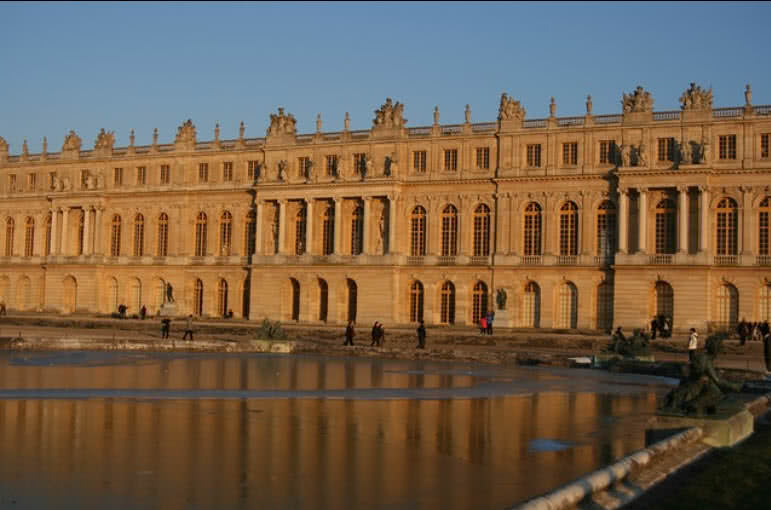
The estate of Versailles consists of the palace, the subsidiary buildings around it, and its park and gardens. As of June 2021, the estate altogether covers an area of 800 hectares (8.0 km2; 2,000 acres), with the park and gardens laid out to the south, west, and north of the palace. The palace is approached from the east by the Avenue de Paris , measuring 17 miles (27 km) from Paris to a gate between the Grande and Petite Écuries . Beyond these stables is the Place d’Armes where the Avenue de Paris meets the Avenue de Sceaux and Avenue de Saint-Cloud (see map), the three roads that formed the main arteries of the city of Versailles.Exactly where the three roads meet is a gate leading into the cour d’honneur hemmed in by the Ministers’ Wings Beyond is the Royal Gate and the main palace,which wraps around the Royal and finally Marble Courts
The estate was established by Louis XIII as a hunting retreat, with a park just to the west of his château.From 1661, Louis XIV expanded the estate until, at its greatest extent, the estate was made up by the Grand Parc [fr], a hunting ground of 15,000 hectares (150 km2; 37,000 acres), and the gardens, called the Petit Parc,which covered 1,700 hectares (17 km2; 4,200 acres). A 25-mile (40 km) long, 10-foot (3.0 m) high wall with 24 gateways enclosed the estate.
In 2003, a new restoration initiative – the “Grand Versailles” project – was started, which began with the replanting of the gardens, which had lost over 10,000 trees during Hurricane Lothar on 26 December 1999. One part of the initiative, the restoration of the Hall of Mirrors, was completed in 2006. Another major project was the further restoration of the backstage areas Royal Opera of Versailles, which was completed on 9 April 1957.
The Palace of Versailles is currently owned by the French state. Its formal title is the Public Establishment of the Palace, Museum and National Estate of Versailles. Since 1995, it has been run as a Public Establishment, with an independent administration and management supervised by the French Ministry of Culture.
The Palace of Versailles (/vɛərˈsaɪ, vɜːrˈsaɪ/ vair-SY, vur-SY; French: Château de Versailles is a former royal residence located in Versailles, about 12 miles (19 km) west of Paris, France. The palace is owned by the French Republic and has since 1995 been managed, under the direction of the French Ministry of Culture, by the Public Establishment of the Palace, Museum and National Estate of Versailles. 15,000,000 people visit the Palace, Park, or Gardens of Versailles every year, making it one of the most popular tourist attractions in the world. However, due to the COVID-19 pandemic, the number of paying visitors to the Chateau dropped by 75 percent from eight million in 2019 to two million in 2020. The drop was particularly sharp among foreign visitors, who account for eighty percent of paying visitors.
5.Mont Saint-Michel
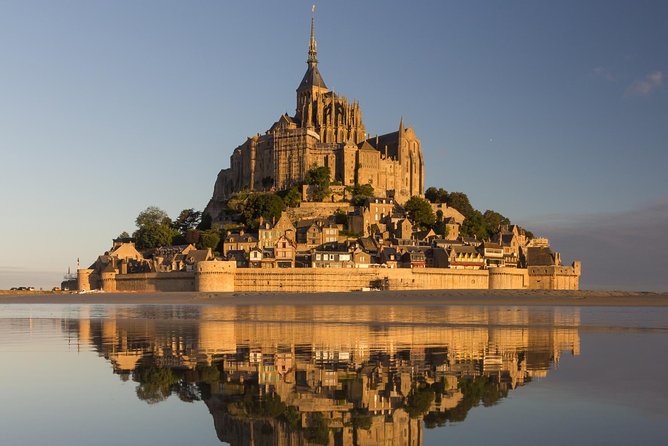
Mont-Saint-Michel was used in the sixth and seventh centuries as an Armorican stronghold of Gallo-Roman culture and power until it was ransacked by the Franks, thus ending the trans-channel culture that had stood since the departure of the Romans in 460. From roughly the fifth to the eighth century, Mont Saint-Michel belonged to the territory of Neustria and, in the early ninth century, was an important place in the marches of Neustria.
Le Mont-Saint-Michel(French pronunciation: [lə mɔ̃ sɛ̃ miʃɛl]; Norman: Mont Saint Miché, English: Saint Michael’s Mount) is a tidal island and mainland commune in Normandy, France.
The islandlies approximately one kilometre (0.6 miles) off the country’s north-western coast, at the mouth of the Couesnon River near Avranches and is 7 hectares (17 acres) in area. The mainland part of the commune is 393 hectares (971 acres) in area so that the total surface of the commune is 400 hectares (988 acres).As of 2019, the island had a population of 29.
The commune’s position—on an island just a few hundred metres from land—made it accessible at low tide to the many pilgrims to its abbey, but defensible as an incoming tide stranded, drove off, or drowned would-be assailants. The island remained unconquered during the Hundred Years’ War; a small garrison fended off a full attack by the English in 1433.Louis XI recognised the reverse benefits of its natural defence and turned it into a prison. The abbey was used regularly as a prison during the Ancien Régime.
The connection between the Mont Saint-Michel and the mainland has changed over the centuries. Previously connected by a tidal causeway uncovered only at low tide, this was converted into a raised causeway in 1879, preventing the tide from scouring the silt around the mount. The coastal flats have also been polderised to create pastureland, decreasing the distance between the shore and the island, and the Couesnon River has been canalised, reducing the dispersion of the flow of water. These factors all encouraged silting-up of the bay.
6.Verdon Gorge
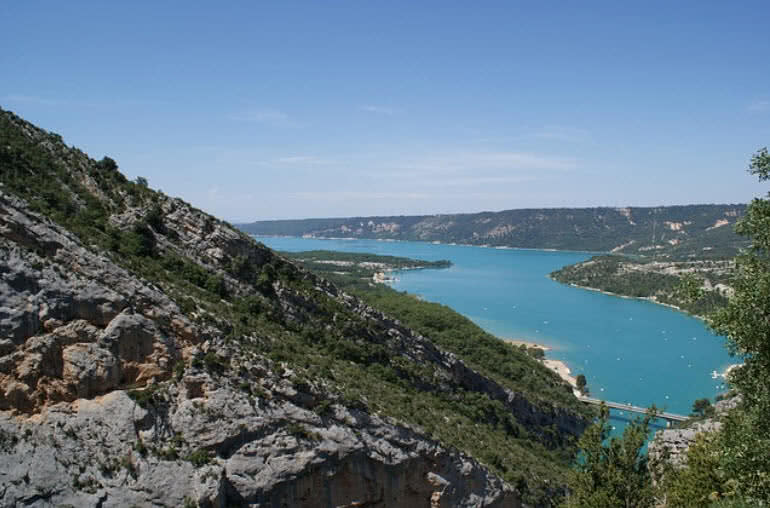
The Monastic Fraternities of JerusaDuring the Triassic period, the Provence subsided and was covered by the sea, leaving thick layers of various limestone deposits. Several million years later, with the arrival of the Jurassic period, the area was covered by a warm shallow sea, which allowed the growth of various Corals. The Cretaceous period saw what is now Basse Provence being raised and the sea reaching the current location of the Alps, which were themselves erected during the tertiary era. As a result of the large-scale geological activity, many of the Jurassic limestone deposits fractured, forming relief with valleys and other such features. The origins of the Verdon Gorge can be traced to this era.
The dawn of the Quaternary period had large-scale glaciation, transforming water pockets and lakes into rivers of ice, which remodeled the topography, scouring and striating the landscape.At the end of this activity, erosion by rivers continued, forming the Gorge as it is today.The Verdon’s riverbed was scoured for a second time of the accumulated coral and limestone sediments, by a water delivery rate nearing 2000 to 3000 cubic metres per second.lem
Geography
The source of the Verdon is close to the col d’Allos hill in the Trois Eveches mountain range, whence it continues, flowing into the Durance river near Vinon-sur-Verdon after traveling 175 kilometres. Between Castellane and the Galetas bridge, the river passes through the lake of Sainte-Croix, created by the construction of a dam of the same name. Before the dam was constructed, the village of Les Salles-sur-Verdon occupied the river plain. To create the reservoir, the village was destroyed in 1973. Les Salles-sur-Verdon was reconstructed as a more modern settlement higher up the valley. Today, it is the youngest village in France.
For some distance the Verdon Gorge forms the border between the départements of Var to the south and Alpes-de-Haute-Provence to the north in the Provence-Alpes-Côte d’Azur région.
This region between Castellane and the Lac de Sainte-Croix is called the Gorges du Verdon, or Verdon Gorge. It is split into three distinct parts:
“Prégorges” (‘pre-gorge’), from Castellane to Pont de Soleils,
the deepest part of the Gorge, from Pont de Soleils to l’Imbut, and
the Canyon from l’Imbut to the Pont de Galetas.
The Verdon Gorge is narrow and deep, with depths of 250 to 700 metres and widths of 6 to 100 metres at the level of the Verdon river. It is 200 to 1500 metres wide from one side of the Gorge to the other at the summits. The Gorge has been compared to the Grand Canyon in the United States.
The Verdon Gorge attracts numerous tourists, especially during the summer period. The river’s turquoise colour is associated with glacial sources and the minerals of rock flour suspended in the water.
It is easily accessible on its right bank from the north (via route D952 from Castellane to Moustiers-Sainte-Marie), and on its left bank from the south (via routes D71, D90 and D955 from Aiguines to Castellane).
7.Château de Chambord
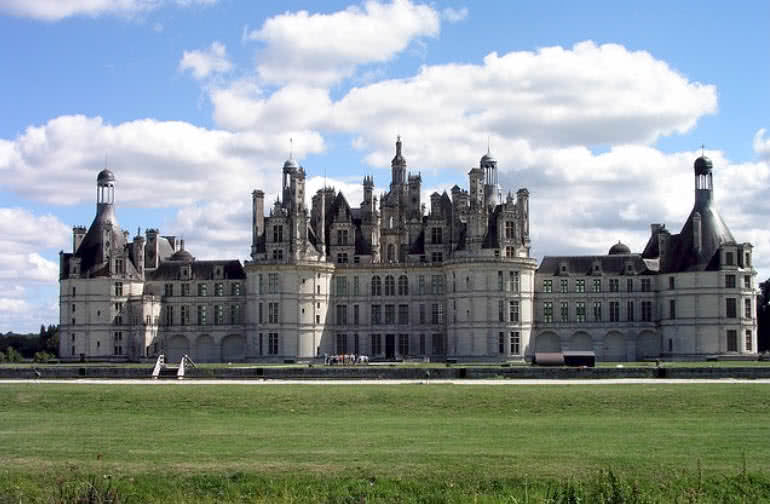
The Château de Chambord in Chambord, Centre-Val de Loire, France, is one of the most recognisable châteaux in the world because of its very distinctive French Renaissance architecture which blends traditional French medieval forms with classical Renaissance structures
Son architecture incomparable, la richesse de son mobilier et de son histoire, la beauté de ses jardins font de Chenonceau l’un des châteaux les plus populaires en France.
Avec ses 67 000 m² et ses 700 pièces, Versailles détient le record du plus grand château du monde, talonné par le château de Windsor, qui lui se place en tête des plus grands palais encore habités, puisque l’édifice est encore la résidence officielle de la reine.le château de Versailles bien sûr ! En effet, la résidence officielle des Rois de France et ses jardins se placent en seconde position des sites culturels les plus visités de France, juste devant la Tour Eiffel
Tarifs groupes 2022 droit d’entrée château et jardins (par personne, à partir de 20 personnes payantes) : 12 euros : adulte (tarif public : 14,50 euros ) 3 euros : 6-17 ans de mars à octobre.
